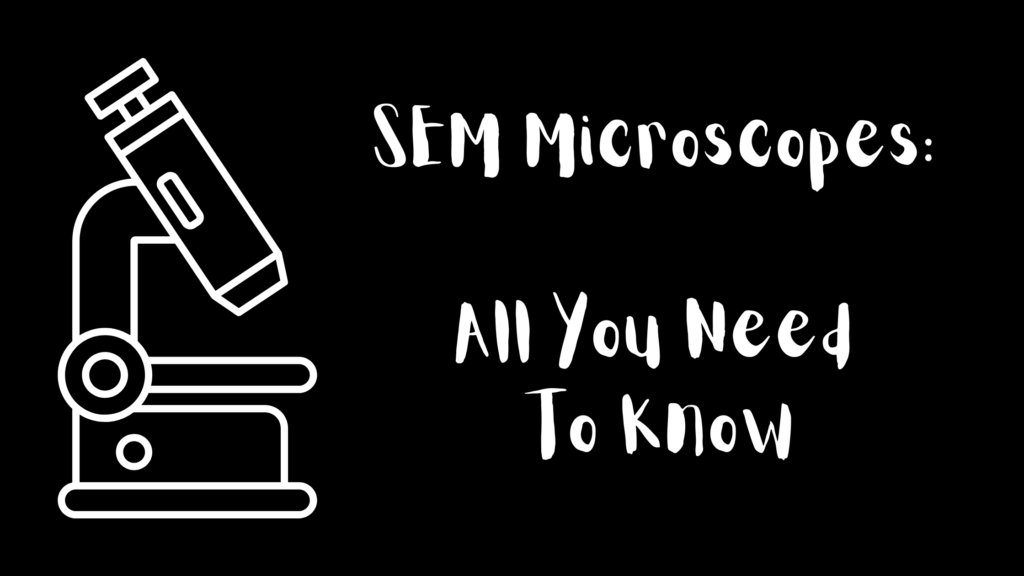What Is an SEM Microscope?
A scanning electron microscope (SEM) is a type of electron microscope that uses a focused beam of electrons to scan the surface of a sample to obtain pictures. Through their interactions with the atoms in the sample, the electrons produce a variety of signals, each of which is encoded with information on the surface topography and chemical makeup of the sample.
To create a picture, the position of the electron beam is merged with the intensity of the received signal after it has been scanned using a raster scan pattern. The topography of the specimen is one of the factors that determines the maximum number of secondary electrons that may be detected and, as a result, the maximum signal strength. There are some SEMs that can achieve resolutions that are better than 1 nm.
How Much Does an SEM Microscope Cost?
The SEM is a complex piece of laboratory equipment. The price of such an instrument can be anywhere from 1 crore to 2 crores of Indian rupees, depending on what kind of instrument it is, how it is made, what parts it has, and how well it works.
How Does the SEM Microscope Work?
The scanning electron microscope (SEM) creates a variety of signals at the surface of solid objects by directing a beam of high-energy electrons down onto the specimens in a concentrated beam. The signals that are produced as a result of interactions between electrons and samples disclose information about the sample, such as its exterior morphology (texture), chemical composition, crystalline structure, and the orientation of the components that comprise the sample.
The majority of applications include the collection of data across a specific region of the surface of the sample and then the generation of a two-dimensional picture that illustrates the spatial changes in the attributes of the sample. Using traditional scanning electron microscopy (SEM) methods, it is possible to view regions spanning in diameter from around one centimeter to five microns (magnification ranging from 20X to approximately 30,000X, with a spatial resolution of 50 to 100 nm).
This method is particularly helpful in qualitatively or semi-quantitatively determining chemical compositions, crystalline structures, and crystal orientations, and it is also capable of performing analyses of selected point locations on the sample. The scanning electron microscope (SEM) can analyze points on the sample that are chosen by the user.
How to Use an SEM Microscope?
- Obtain a sample that has been prepared. For scanning electron microscopy (SEM), a sample needs to be the right size and have a surface that conducts electricity.
- In order to open the sample door, you will need to bring the SEM to atmospheric pressure. Be aware that the scanning electron microscope (SEM) will always have power and that the sample chamber will always be in a vacuum. This ensures that electrons will have a path that is unobstructed as they make their way toward the sample, as the chamber will be devoid of any and all gas molecules. Keep pressing and holding the VENT button until you see a flashing light and hear a clicking sound.
- Please wear some gloves. This is the most important thing to do because the chamber of the SEM must always be in perfect shape.
- Make a gentle sliding motion out of the door by using the knobs on each side of the door.
- After the door has been opened, grab the sample holder, and then move it to the right. At that point, it will separate itself from its grooves, at which point you will be able to load your sample.
- There is one set screw located on each of the four corners of the sample holder. First, give these screws a very small turn with the screwdriver (about half a turn should be sufficient), and then remove the blank sample from the holder.
- After you’ve put your sample where you want it, you can move the sample holder so that it fits snugly between the grooves on the sample stage.
- To return the chamber to its previous vacuum state, push and maintain pressure on the EVAC button until it begins to blink while the door is being held shut. There will be a series of clicks, and then, after about a minute, you will hear the pump turbines starting to spin up.
- These pumps will evacuate all gas particles from space, lowering the pressure to around 10-6 t/s. When the EVAC button emits a steady green glow, it indicates that the chamber has reached a vacuum state.
- Wait for five minutes, then activate the electron beam and begin capturing images.
You should be able to access the microscope software on the PC that is attached to the SEM. When the electron beam is turned off, a message that says OFF will appear on the green button located in the upper right corner of the screen. Simply clicking it will activate the beam, at which point it will indicate ON. - After that, select the sample you want to look at by clicking the option labeled “ACB,” which stands for “automatic contrast and brightness.”
- Adjust the level of magnification on the control panel by turning the magnification knob to the appropriate setting. It is a good idea to perform your focusing at a larger magnification than you desire for your image. As a result, when you zoom out, your image will seem much better. If you want a picture at 2,500 times magnification, for instance, you should probably concentrate at roughly 4,000 times that magnification.
- When you have the desired magnification, turn the focus knob to bring the image into sharp focus.
Micron Optik
You can reach out to the helpful folks at Micron Optik with any questions or concerns you have right now. Micron Optik makes state-of-the-art microscopes, compound microscopes, and other microscopy equipment that are used in universities and labs all over the world.
Micron Optik’s premium microscopes are part of our effort to cater to a wide range of customers. We only sell the highest quality scanning electron microscopes (SEMs).
People Usually Search Keywords: Microscope Manufacturers | Laboratory Microscope | Microscope Manufacturers in India | Microscope Supplier | Microscope Suppliers in India | Laboratory Microscope Suppliers | Microscope Manufacturers in Ambala | Microscope India | Best Microscope Manufacturers | Microscope Ambala | Microscope Online India | Microscope Brands in India | Microscope Companies in India | Microscope Online Shopping India | Top Microscope Brands in India | Indian Microscopes | Microscope India Suppliers | Top Microscope Manufacturers | Best Microscope Brands | Best Microscope Companies | Microscope Brands | Microscope Companies | Microscope Vendors
What Is a Binocular | Binocular Microscopy | Binocular Microscope | Binocular Microscopes | Binoculars Microscope | Microscope Binocular | Uses of Binocular Microscope | Binocular Microscope Principle | Microscope Comments | Microscope Definition Biology | Define Binocular | What Is Binocular
Uses of Microscope | What Is Microscope | 10 Uses of Microscope | Uses of Lenses in Our Daily Life | Explain Microscope | Define Microscope | 5 Uses of a Microscope | Convex Lens Uses in Daily Life | What Are Its Uses | Purpose of Microscope | Application of Simple Microscope | Use of Simple Microscope | Uses of Simple Microscope | Use of Microscope | Application of Microscope | Uses of Lens in Daily Life
Who Discovered Microscope | Who Invented Microscope | Who Invented the Microscope in 1666 | Zacharias Janssen Microscope | Who Discover Microscope | Who Made the Microscope | Microscope Invented by | Who Invented Compound Microscope | Who Invented the Microscope and When | Microscope Inventor Name | Who Founded Microscope | Microscope in Kannada
What Is a Compound Microscope | Compound Microscope Comments | Compound Microscope Information | Compound Microscope | Compound Microscope Explanation | Discovery of Compound Microscope | Why Is Light Microscope Called a Compound Microscope | Types of Compound Microscope | Compound Microscope Practical | Describe Compound Microscope | About Compound Microscope | Which Lens Is Used in Compound Microscope | Comments on Compound Microscope | Components of Compound Microscope | Explain Compound Microscope | History of Compound Microscope | Study of Compound Microscope










